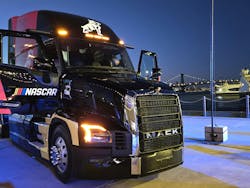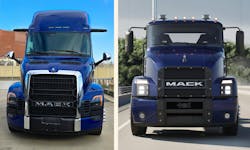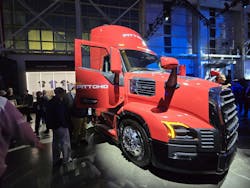First impressions of the Mack Pioneer: Old bulldog learns new tricks
BROOKLYN—On April 8, in a crowded Brooklyn Navy Yard warehouse, Mack Trucks celebrated its milestone 125th anniversary with the same moxie that made its trucks famous and made the brand synonymous with bulldogs. The warehouse was chock full of restored vintage Mack truck models—and human models dressed to the nines in early 20th-century fashion. It all seemed lifted straight from “The Great Gatsby.” Two gents even donned getups to imitate founders Jack and Gus Mack, who built the company’s first vehicle, a sightseeing bus, just three miles away from the soiree. No doubt the most popular party animal was Walter the bulldog, a stout lad hanging out near a restored Mack AC. That early Mack marvel looked so much like a bulldog that it earned this nickname from British Tommies during World War I.
But this event served the dual purpose of a glitzy truck launch as well as a glamorous birthday extravaganza. So after a bit of revelry, the 800 or so folks sauntered to an adjacent warehouse for the literal unboxing of the company’s latest on-highway Class 8 tractor. After a video intro by Mike Rowe and a series of speeches, the digital wrapping (really three oversized video walls) were hoisted up, presenting the Mack Pioneer to the world.
The most important thing to know is that the leaner semi keeps the toughness and reliability that built the brand, adding fuel efficiency and driver comfort that fleets are looking for.
It's been in the works since 2017—the year the Class 8 Mack Anthem was launched—and according to Martin Lundstedt, president and CEO of parent company Volvo Group, is the result of a $2 billion investment. It’s because Mack, one of the first and oldest truck OEMs, is now staunchly planted in the future, one where the company bullies back some of the on-highway market share it’s lost over the decades.
The company, which pre-dates modern highways by half a century, has a 2% OTR market share. Market leader Daimler Truck owns closer to 40% and its Freightliner Gen-5 Cascadia, itself decked out in the latest safety and efficiency technology, is revving up production this summer.
Mack would settle for closer to 10% market share by 2030 for its OTR and vocational segments combined. This will also be helped with next-gen Anthem and electric Pioneer down the line, while Mack tacitly suggested its workhorses, the Pinnacle and Granite, would receive a refresh at some point.
On this high-octane night, they just wanted to show the world that Mack hasn’t lost its swagger or penchant for innovation.
“Today is an opportunity to redefine the new future for Mack, while at the same time staying true to what it means to be built like a Mack truck,” Lunstedt said.
Mack President Stephen Roy, meanwhile, suggested the Pioneer would be a “competitive advantage on wheels” for fleets and owner-operators due to a heap of new features and upgrades ranging from better fuel economy and optional digital mirror systems to wider door entries and expanded berthing space for sleeper models.
Jonathan Randall, Mack Trucks North America president, went further, calling the Pioneer the industry’s “new standard in efficiency and comfort, safety and uptime.”
Those are bold statements, but what is a pioneer if not bold?
Aerodynamics and efficiency features:
- Recessed bulldog placement: Keeps iconic symbol front and center while reducing wind drag
- Three-piece hood: Aerodynamic, but also allows for replacement of individual sections if damaged
- Aero windshield: Improved visibility in addition to better fuel economy
- Front/rear wheel closeouts: Push air around the wheel to reduce drag
- Chassis fairings: Cab skirt is fully-enclosed, covering fuel and DEF tank access
Here’s the skinny
Even a cursory glance tells you this truck marches to a different beat than the Anthem. Where Mack’s over-the-road truck released in 2017 had an arching, almost bulbous, hood and blocky front profile that would not seem out of place in Minecraft, the Pioneer was crafted with a lither look, one that suggests a pedigree may have some greyhound in its lineage.
It’s sleek and sinewy, as the designers refused to compromise on either the classic Mack toughness or modern fleets’ preference for an aerodynamic aesthetic. If Shell’s futuristic Starship is the bullet train of trucking, then this surely is the .50 caliber round.
Earlier in the day at a media preview, lead designer Lukas Yates asserted the Pioneer is “the most aerodynamic diesel truck out there.” That’s saying something considering Volvo Trucks North America launched its latest heavy-duty aero feat, the All-New Volvo VNL, less than 15 months ago, which boasted a 10% fuel efficiency advantage over the previous version. Starting from scratch, the Pioneer blazes through trails and air, owning an 11% advantage over the Anthem, besting even Mack’s internal aero targets, according to Yates.
“Every surface, every interface, was optimized for aero to make sure that air flows the way it needed to give us the air targets,” he explained.
Power up
Aero accounts for 8% of the efficiency upgrade, while the rest comes from a revamped integrated powertrain, comprising Mack’s new MP13 engine and mDrive transmission. Mack, by the way, takes credit for integrating the engine, transmission, and axles into one cohesive system. The Pioneer’s powertrain comes in a few different power levels, reaching up to 515 HP and 1,950 lb.-ft. of torque. (The first motorized vehicle made by the Mack Brothers, Jack, Gus, and William, a 20-seater sightseeing bus in Brooklyn, had 40 HP.)
Of course, the MP13 is a vast improvement over that in power, while over the MP8, it’s about 3%. A new wave piston design and other tweaks enable that, the company said. Some other enhancements include 13-Speed Dynamic Overdrive to switch between efficiency and power modes and help get that extra oomph up steep inclines, and a beefed up engine brake to get the tractor-trailer to stop.
Drivers should notice the updated mDrive has 30% better shifting performance due to sensor and hardware changes. Jack Mack’s great grandson, Tom Mack, a now retired employee who worked on the Pioneer and attended the event, was quick to remind people his great-great uncle Gus was the one who invented the mesh feature on transmission gears to make shifting from low to high more smooth, and thus helping the metal gears last longer. On the new mDrive, a redesigned clutch improves its durability.
Fleet first impressions
The completely redesigned semi has been in the works since 2017, when the current class 8 flagship, the Anthem, debuted. According to Mack, they talked to about 100 fleets and several dealers to make this the perfect truck for today’s demands.
One of those was Pitt Ohio, which relies on several OEMs for its LTL operations, with models including the Anthem and VNR Electric. The company's red Pioneer day cab is already wrapped in fleet branding and made an appearance at the launch party.
“Mack really took a lot of feedback and tried to put a product together that would stand out and be a leader in the space as we move into the future,” explained Taki Darakos, VP of maintenance and fleet operations at Pitt Ohio.
He said the fleet will receive a small order this summer and larger group in Q1 2026.
“We’re excited about the technology that this tractor provides in the areas of efficiency, maintenance, safety, and driver comfort,” Darakos added.
Jamie Hagen, owner of Hell Bent Xpress and one of the biggest Mack backers you’ll meet, already can average over 10 mpg with his high-efficiency Anthem and is salivating at the prospect of possibly reaching more.
“11% puts you over 11 mpg, right?” he said at the event. “So I'm excited to see if that number will hold true. It should with all the extra aerodynamics—we couldn't squeeze one more fuel-efficient thing in it if we wanted to.”
Hagen meticulously tracks fuel costs, a must for underdogs competing with fleets several orders of magnitude larger, and thinks this will indeed be a “competitive advantage on wheels,” as Roy said.
“It's going to be close to three quarters of a mile per gallon savings, and that's roughly around six cents a mile in just fuel savings,” he said, using current diesel costs.
Having driven the truck already, he also noted “how much smoother and quieter the cab is,” due in part to the new MaxRide Air suspension option, which offers eight tuned airbags and electronic ride height.
“The new air ride suspension that they put on not only lends itself to a better ride, but is non-torque reactive, which is a huge thing for traction.”
Overall look
The semi retains the sharp lines that reflect its rugged reliability, and the bulldog, of course, while adding several exterior aerodynamic flourishes to enhance fuel efficiency, such as the two air intakes on the side near the doors and two on the hood. The latter flank the canine hood ornament, which was knocked off its pedestal and brought forward into a recess to reduce drag even more, “making it an integral part of the truck’s performance rather than just an emblem,” Yates said.
“Not only did they approve the aerodynamics, but I think they came out with a really bold looking truck, even though the anthem was bold in itself,” Hagen said. “I feel like they've got even more rugged with this look.”
It's one example that Mack’s Pioneer design team pored over every detail to ensure this truck isn’t just the 125-year-old OEM’s crowing achievement, but king of every road it’s on.
Another is how the Mack badge on the bigger grille (reinforced by metal mesh) has a top-down view of the Brooklyn Bridge on it, a nod to the Mack Brothers time in the borough before moving operations to Allentown, Pennsylvania. The Pioneer will be made in the Lehigh Valley Operations plant, with production starting this summer, by the way.
That bridge element carries over to the headlamps for a clean but imposing look. Anyone who says this is just a rebadged version of the all-new Volvo VNL needs to look again. While similar, the revamped VNL has a bit more graceful face, giving off Afghan hound vibes.
Driver comfort features:
- Wider cab: 9 inches of additional width creates a more spacious interior
- MaxRide Air: Upgraded suspension uses airbags to provide the most stable ride ever offered by a Mack truck
- Steering wheel ergonomics: The flat-bottom design of the wheel provides more room and easy access infotainment/cruise control operation.
- Integrated parking cooler: Maintains cabin temperature and environment without idling, reducing fuel costs.
- High-back seat: Offers heating, cooling, and massage
Driver comfort
There’s certainly some sibling rivalry at Mack, and one aspect where being so close to Volvo, a leader in comfort, benefited them was on the interior. Mack now offers a FlexSuite option for its sleeper cabs, meaning you can flip the murphy bed up and create a little office. The latest VNL introduced this concept.
According to Hagen, “that's 100% a game changer for Mack, finally getting that from their sister organization.” Because he drives and manages eight other trucks, his time off the clock is never really time off, and the FlexSuite can become a spacious mobile office or bedroom with little effort.
“As a business owner, now I'm able to not only drive the truck, but now at night, set my laptop up, do some work, eat in the cab, all that stuff—basically live in the truck more comfortably than I did before.”
Less effort overall is made getting down from the bunk or in and out of the cab, with the addition of metal extruded grab points.
Hagen noted the ergonomics, such as “putting the handles inside the cab versus outside” and “being able to crawl in there without getting your hands dirty” are also major improvements.
But he goes back to what matters most—being behind the wheel.
“As a driver, I’m more looking forward to just the smooth, quiet ride—not that it was bad before [in the Anthem]. But this thing is a whole next level. It's super exciting.”
He concluded by calling it one thing you haven’t likely heard much with Mack but will likely hear a lot more about in the future.
“It’s luxury,” Hagen finished.
About the Author

John Hitch
Editor-in-chief, Fleet Maintenance
John Hitch is the award-winning editor-in-chief of Fleet Maintenance, where his mission is to provide maintenance leaders and technicians with the the latest information on tools, strategies, and best practices to keep their fleets' commercial vehicles moving.
He is based out of Cleveland, Ohio, and has worked in the B2B journalism space for more than a decade. Hitch was previously senior editor for FleetOwner and before that was technology editor for IndustryWeek and and managing editor of New Equipment Digest.
Hitch graduated from Kent State University and was editor of the student magazine The Burr in 2009.
The former sonar technician served honorably aboard the fast-attack submarine USS Oklahoma City (SSN-723), where he participated in counter-drug ops, an under-ice expedition, and other missions he's not allowed to talk about for several more decades.







